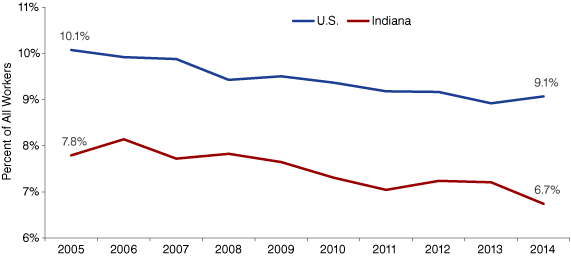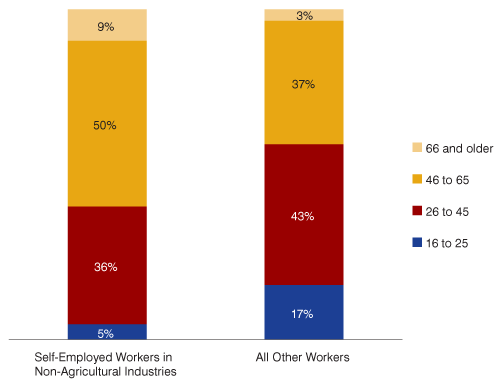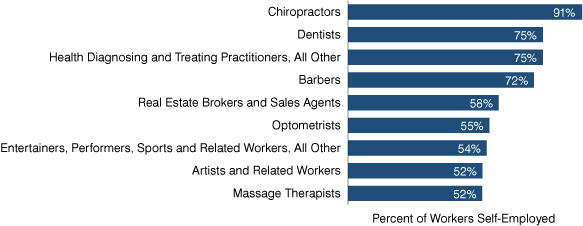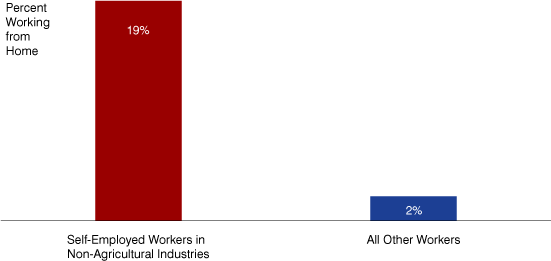A Closer Look at Self-Employment in Indiana
Differing definitions of self-employment can make it tricky to pinpoint just how many of Indiana’s 3.1 million employed workers are self-employed. The most commonly used measures of self-employment can be divided into two categories: estimates that are based on survey data (such as the Census Bureau’s Current Population Survey and American Community Survey) and those compiled based on tax return data (the Census Bureau’s nonemployer statistics or counts of Schedule C and Schedule SE income tax returns from the Internal Revenue Service). These measures each have their own advantages and disadvantages—and can yield very different results due to differences in the methodologies and definitions used. This article uses microdata from the American Community Survey (ACS) to analyze non-agricultural self-employment in Indiana.
The ACS is a Census Bureau survey that collects data on the demographic, social, economic and housing characteristics of American households each year. The survey measures self-employment based on whether individuals describe their current or most recent job activity as one of the following:
- “Self-employed, in own not incorporated business, professional practice, or farm”
- “Self-employed, in own incorporated business, professional practice, or farm”
Because of the different nature of self-employment in the agricultural sector, it is common to analyze agricultural self-employment and non-agricultural self-employment separately. This article focuses specifically on self-employment in non-agricultural industries, so individuals who identify as self-employed but work in an agricultural industry are not counted among the self-employed unless otherwise noted.
In 2014, approximately 13.4 million workers were self-employed in non-agricultural industries in the United States, accounting for 9.1 percent of employed people. In Indiana, the self-employed made up a smaller proportion of workers, with 207,148 self-employed non-agricultural workers (6.7 percent of total employment).
The ACS data allow us to distinguish between self-employed workers who have incorporated their businesses and those who have not. There are many reasons a person might incorporate a business, including reduction of personal liability, tax benefits and additional funding options. In 2014, an estimated 79,403 self-employed Hoosiers worked in a business that they had incorporated.
Table 1: Indiana Employment Estimates, 2014
| Category | Number | Percent of Total Employment |
|---|---|---|
| Total Employment in Indiana | 3,072,739 | 100.0% |
| Agricultural and Related Industries | 31,236 | 1.0% |
| Non-Agricultural Industries | 3,041,503 | 99.0% |
| Not Self-Employed | 2,834,355 | 92.2% |
| Self-Employed | 207,148 | 6.7% |
| Self-Employed, Incorporated | 79,403 | 2.6% |
| Self-Employed, Not Incorporated | 127,745 | 4.2% |
Source: Indiana Department of Workforce Development, using U.S. Census Bureau ACS data
The percentage of workers who are self-employed has been declining over the past decade, both in Indiana and nationwide (see Figure 1). The trend seems to be ongoing and appears to be independent of the economic downturn of the late 2000s.
Figure 1: Self-Employment Rates Are Declining, Both in Indiana and Across the Nation

Note: These data show non-agricultural self-employment.
Source: Indiana Department of Workforce Development, using U.S. Census Bureau ACS data
Who Are Indiana’s Self-Employed Workers?
Using the five-year ACS Public Use Microdata Sample (PUMS) data, we can produce estimates that allow us to compare the demographics of self-employed Hoosiers to the rest of the workforce.
Comparing the age distribution of self-employed workers to that of other employees suggests that the self-employed tend to be older than other workers (see Figure 2). Self-employment seems to become more common as workers enter their 40s and remains relatively popular up to and beyond typical retirement ages.
Figure 2: Age Distribution of the Self-Employed and Other Workers in Indiana

Source: Indiana Department of Workforce Development, using U.S. Census Bureau 2010-2014 PUMS data
In addition to being older, self-employed workers are predominantly male. Although men make up just 52 percent of total employment in Indiana, 63 percent of self-employed Hoosiers are male.
The self-employed don’t seem to be remarkably different from other workers in terms of educational attainment, except that a higher percentage of self-employed workers (12.8 percent) hold a graduate or professional degree compared to all other workers (8.6 percent).
Why Are People Self-Employed?
There are competing narratives regarding what leads people to become self-employed. Some see the self-employed as entrepreneurs—ambitious and willing to take on risks in order to achieve individual success and independence.1 Others see self-employment as more of a fallback position for people who struggle to find or maintain other forms of employment. Since the self-employed are a diverse group, it is unlikely that a single characterization of the self-employed will accurately define this sector of the workforce.
In a study of the relationship between self-employment rates and unemployment rates,2 researchers confirmed that there are two distinct relationships:
- The effect of entrepreneurs whose innovation and effort ultimately drive unemployment rates down
- The effect of “refugees” who resort to self-employment due to necessity when unemployment rates rise
Ultimately, the researchers found that the “entrepreneurial” effect (self-employment that reduces unemployment) tends to be stronger than the “refugee” effect. So while reasons for being self-employed may be different for each individual worker, the overall description of the self-employed as entrepreneurs who contribute to economic growth may be more apt than the portrayal of the self-employed as workers who are out of options and work for themselves only out of necessity.
What Do Self-Employed Workers Do?
Self-employment is much more common in some occupations than in others. Self-employment in Indiana is heavily concentrated among health care practitioners, as well as entertainers and artists (see Figure 3).
Figure 3: Occupations with Highest Percentage of Self-Employed Workers in Non-Agricultural Industries in Indiana

Source: Indiana Department of Workforce Development, using U.S. Census Bureau 2010-2014 PUMS data
Figure 4 shows that the occupations accounting for the highest number of self-employed workers in Indiana include service occupations such as child care workers, hairdressers and real estate agents, as well as construction and transportation occupations like carpenters, construction workers and truck drivers.
But topping this list is the somewhat mysterious “miscellaneous managers” category. A closer analysis of this group indicates that self-employed miscellaneous managers worked in a variety of service industries, the most common being automotive repair, computer systems design, architecture and engineering, consulting, and advertising.
A similarly vague occupation group title is “first-line supervisors of retail sales workers.” Analyzing the most common industries of self-employed workers in this group indicates that these are likely people who run their own retail stores. The most common industry descriptions they chose include miscellaneous retail stores, used merchandise stores, gift shops, florists and electronic shopping.
Figure 4: Occupations with Highest Number of Self-Employed Workers in Non-Agricultural Industries in Indiana

Source: Indiana Department of Workforce Development, using U.S. Census Bureau 2010-2014 PUMS data
The Self-Employed Lifestyle
There are many known advantages and disadvantages to self-employment. Studies suggest that the self-employed feel they have more control over their lives and report higher levels of life satisfaction and work satisfaction—but they may also experience poorer work-life balance, with more stress, lost sleep and exhaustion.3
The benefits of self-employment include the flexibility and independence of being your own boss. In Indiana, self-employed workers are nearly 10 times as likely to work from home as other workers (see Figure 5).
Figure 5: Self-Employed Hoosiers Are Nearly 10 Times More Likely to Work from Home than Other Workers

Source: Indiana Department of Workforce Development, using U.S. Census Bureau 2010-2014 PUMS data
And of those who don’t work from home, the self-employed tend to begin working later in the day compared to their employee counterparts, with fewer workers starting work before 8 a.m. (see Figure 6).
Figure 6: Self-Employed Hoosiers Tend to Arrive at Work Later than Other Workers

Note: These data exclude those who work from home.
Source: Indiana Department of Workforce Development, using U.S. Census Bureau 2010-2014 PUMS data
One of the potential drawbacks of self-employment is the relative lack of fringe benefits, particularly health insurance. Research has shown that workers are less likely to transition to self-employment when it means losing access to health insurance or when a member of their family is in bad health.4 Some researchers have predicted that this barrier to self-employment will be broken down as the Affordable Care Act increases access to health insurance for self-employed workers.5 Based on the ACS data, it is estimated that 78 percent of self-employed workers in Indiana have health insurance coverage, compared to 86 percent of other workers.
Notes
- Robert B. Reich, "Entrepreneur or Unemployed?," New York Times, June 1, 2010.
- A. Roy Thurik, Martin A. Carree, André Van Stel, and David B. Audretsch. "Does Self-Employment Reduce Unemployment?," Journal of Business Venturing 23, no. 6 (2008): 673-686.
- See David G. Blanchflower, Self-Employment: More May Not Be Better, NBER Working Paper No. 10286, National Bureau of Economic Research, 2004, www.nber.org/papers/w10286, and Peter van der Zwan, Jolanda Hessels, and Cornelius A. Rietveld, The Pleasures and Pains of Self-Employment: A Panel Data Analysis of Satisfaction with Life, Work, and Leisure, Tinbergen Institute Discussion Paper No. 15-099/VII, 2015.
- Robert W. Fairlie, Kanika Kapur, and Susan Gates. "Is Employer-Based Health Insurance a Barrier to Entrepreneurship?," Journal of Health Economics 30, no. 1 (2011): 146-162.
- Linda J. Blumberg, Sabrina Corlette, and Kevin Lucia, The Affordable Care Act: Improving Incentives for Entrepreneurship and Self-Employment, Urban Institute, 2013.
